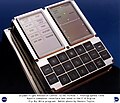Tiedosto:Apollo display and keyboard unit (DSKY) used on F-8 DFBW DVIDS683588.jpg
Siirry navigaatioon
Siirry hakuun

Tämän esikatselun koko: 765 × 600 kuvapistettä. Muut resoluutiot: 306 × 240 kuvapistettä | 612 × 480 kuvapistettä | 980 × 768 kuvapistettä | 1 280 × 1 004 kuvapistettä | 2 560 × 2 007 kuvapistettä | 3 030 × 2 376 kuvapistettä.
Alkuperäinen tiedosto (3 030 × 2 376 kuvapistettä, 6,18 MiB, MIME-tyyppi: image/jpeg)
Tiedoston historia
Päiväystä napsauttamalla näet, millainen tiedosto oli kyseisellä hetkellä.
| Päiväys | Pienoiskuva | Koko | Käyttäjä | Kommentti | |
|---|---|---|---|---|---|
| nykyinen | 9. lokakuuta 2021 kello 09.29 |  | 3 030 × 2 376 (6,18 MiB) | Huntster | Cropped 9 % vertically using CropTool with lossless mode. |
| 9. lokakuuta 2021 kello 09.28 |  | 3 030 × 2 606 (5,97 MiB) | Huntster | Full resolution from NASA. | |
| 6. toukokuuta 2015 kello 03.42 |  | 1 536 × 1 321 (303 KiB) | Fæ | == {{int:filedesc}} == {{milim | description = {{en|1=The display and keyboard (DSKY) unit used on the F-8 Digital Fly-By-Wire (DFBW) aircraft during Phase I of the fly-by-wire program. Warning lights are in the upper left section, displays in the uppe... |
Tiedoston käyttö
Seuraava sivu käyttää tätä tiedostoa:
Tiedoston järjestelmänlaajuinen käyttö
Seuraavat muut wikit käyttävät tätä tiedostoa:
- Käyttö kohteessa ar.wikipedia.org
- Käyttö kohteessa en.wikipedia.org
- Käyttö kohteessa es.wikipedia.org
- Käyttö kohteessa fr.wikipedia.org
- Käyttö kohteessa he.wikipedia.org
- Käyttö kohteessa hu.wikipedia.org
- Käyttö kohteessa ja.wikipedia.org
- Käyttö kohteessa pl.wikipedia.org
- Käyttö kohteessa ru.wikipedia.org
- Käyttö kohteessa uk.wikipedia.org


